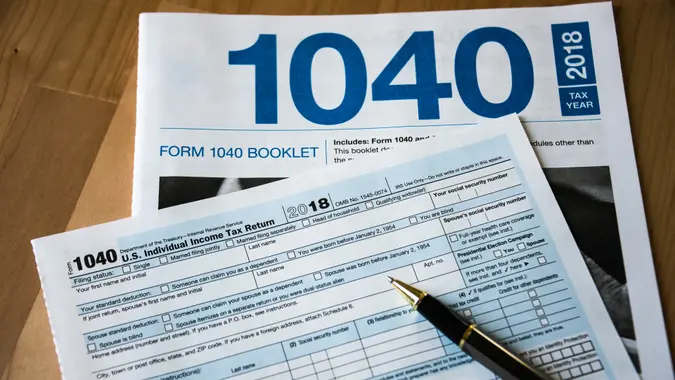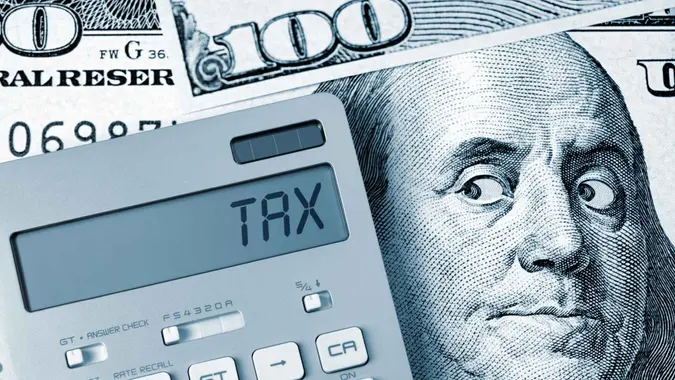How To Boost Your Odds of Getting a Tax Refund Going Forward

Commitment to Our Readers
GOBankingRates' editorial team is committed to bringing you unbiased reviews and information. We use data-driven methodologies to evaluate financial products and services - our reviews and ratings are not influenced by advertisers. You can read more about our editorial guidelines and our products and services review methodology.

20 Years
Helping You Live Richer

Reviewed
by Experts

Trusted by
Millions of Readers
Although most Americans don’t enjoy filing their taxes, getting a refund is very popular. According to the IRS, over 75% of all returns processed in 2021 generated a refund, with the average amount topping $2,800. If you’re looking to maximize your tax refund, there are steps you can take to nearly ensure that you’ll get one, as outlined below. Just be sure you understand exactly what a refund is before you generate a large one — it might not be the source of “free money” that you think.
Increase Your Federal Tax Withholding
The most direct way to increase your chances of a refund is to change your W-4. Your W-4 tells your employer how much money to withhold from each of your paychecks. Although the IRS provides a guide as to how many withholding exemptions you should take, you’re free to increase this amount if you want more money held back from your check. The more you hold back, the more likely you’re going to receive a tax refund the following year.
Claim Everything You’re Entitled To
The IRS is actually quite generous when it comes to deductions and credits that taxpayers can take. But it doesn’t go out of its way to highlight these potential benefits. It’s up to you as a taxpayer to identify relevant exemptions, deductions and credits that can help boost your refund. Some of the most popular include:
- Dependents
- Child and dependent care credit
- Earned income tax credit
The earned income tax credit is one that many families should pay more attention to. This credit primarily assists low- to moderate-income families with children, and the average credit amount in 2021 was about $2,411. Yet, approximately 20% of eligible filers don’t claim it. If you’re looking to maximize your refund, pay special attention not to overlook this credit, if applicable.
Beyond these more traditional measures, look into more obscure credits that can help increase your refund, such as clean energy credits and the retirement savings contributions credit, commonly known as the saver’s credit. This latter credit can provide you with a tax credit of up to $1,000 ($2,000 if married filing jointly) simply for contributing to your retirement plan.
Kick In to Your Retirement Plan
The deadline to get a tax deduction for 401(k) is the end of the calendar year, but you’ve got until April 18 to get credit for IRA contributions. For tax year 2022, you can contribute up to $6,000 to an IRA, with an additional $1,000 allowed if you’re age 50 or older. If you’re in the 22% tax bracket, not only are you boosting your retirement savings by $7,000, but you’re also getting a $1,540 tax deduction. It’s like getting paid $1,540 to put money in your savings, which is an amazing deal any way you look at it.
Determine Whether You Run a Business
The tax code has many generous provisions to reduce taxation on business owners. As part of the Tax Cuts and Jobs Act of 2018, the qualified business income deduction allows a wide range of business owners, including sole proprietors, partnerships and S corporations, to deduct 20% of their qualified business income. This is on top of the numerous deductions allowable to most businesses, such as the cost of supplies, business meals and trips, insurance, rent, utilities and many more. Remember that business deductions don’t just apply to Fortune 500 companies. For example, if you rent out an apartment, sell crafts on Etsy or work a side gig as an Uber driver, you likely qualify for many business deductions. These can be immensely helpful if you’re looking to maximize your tax refund.
Remember What a Tax Refund Really Is
In one sense, the IRS is deceptively clever when it comes to tax refunds. There’s no denying the thrill attached to receiving “free” money from the government in the form of a tax refund. But the reality is that a tax refund is simply a return of your overpayments to the government throughout the course of the year. Breaking it down even further, when you get a tax refund, it means you’ve provided the government with an interest-free loan of your own money during the course of the year. It’s like investing in a Treasury bill that pays you no interest — you simply get your money back at its maturity date, which in this case is whenever you file your taxes. Although no one likes owing the government money, working too hard to score a huge refund is actually financially counterproductive.
 Written by
Written by  Edited by
Edited by 

























